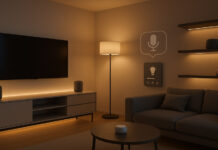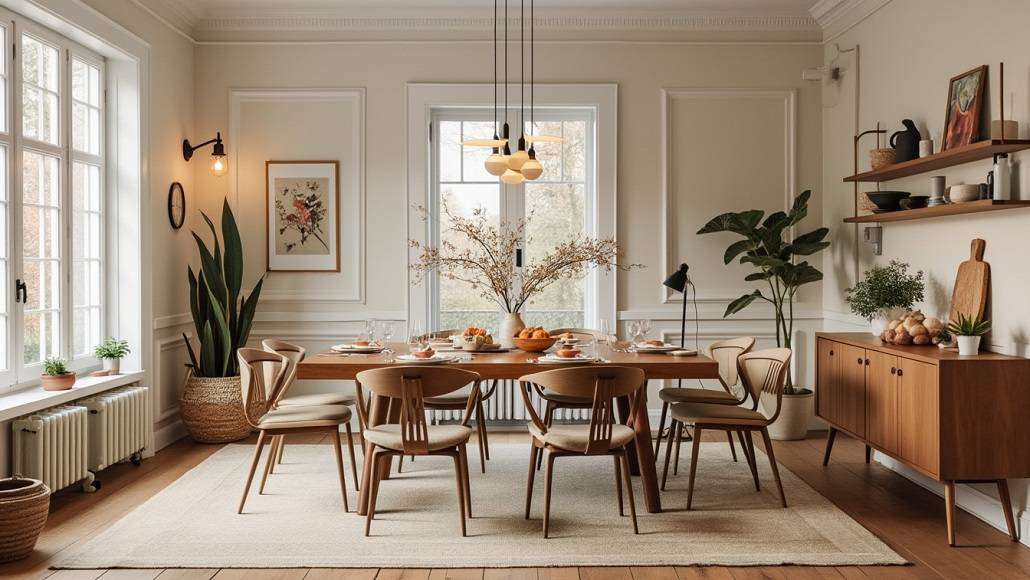After working with hundreds of dining room projects over the years, we’ve noticed the same mistakes keep happening. People get caught up in Pinterest-perfect images and forget that dining rooms need to work for real life – messy family dinners, homework sessions, and hosting friends who spill wine.
The truth about dining room decor is that most of the “inspiration” you see online won’t work in your actual house. Those gorgeous photos are styled for cameras, not for living. Real dining room design comes down to getting the basics right first, then adding personality that matches how you actually use the space.
The Truth about Dining Room Lighting Everyone Gets Wrong
Why Chandeliers Aren’t Always the Answer
Everyone thinks they need a statement chandelier for their dining room, but here’s what lighting designers won’t tell you: Chandeliers work in maybe 60% of dining spaces. If your room has low cs, a busy layout, or lots of natural light, that big chandelier might make the space feel cramped and overdone.
The dining room chandelier obsession stems from formal dining traditions that no longer align with how most families eat today. If you’re using your dining table for kids’ art projects and laptop work, you need lighting that accommodates these activities as well.
Layered Lighting That Actually Works for Dining
Bright dining room lighting utilizes three types: ambient (your primary light source), task (for tasks such as reading menus or homework), and accent (for setting the mood during dinner parties). This might mean a smaller ceiling fixture plus table lamps or wall sconces.
Lighting Design: For 2025, we’re seeing more people opting for a more modern approach, skipping the traditional chandelier light altogether. Instead, they’re using pendant lights over the table, along with floor lamps in the corners and possibly some LED strips behind a sideboard. This approach gives you way more control over the mood.
A lighting professional we know always tells clients the same thing: you need four different types of lighting working together. These include task lighting for reading menus, ambient lighting for general brightness, accent lighting for highlighting art, and decorative lighting that looks good even when it’s off. When you get all four working together, your dining room becomes a warm, inviting space that accommodates everything from homework to dinner parties.
Furniture Layout Mistakes That Kill Your Dining Space
● The Dining Table Sizing Rule Designers Swear By
Here’s the sizing rule most people get wrong: you need 36 inches of clearance around your dining table for chairs to pull out comfortably. That means if your dining area is 10×12 feet, your table can’t be bigger than about 4×8 feet at its maximum. We often see people cramming huge tables into small spaces, which makes the whole room feel claustrophobic.
One designer we work with puts it perfectly – when there isn’t at least 36 inches of clearance around all sides of the dining table and chairs, you’re making a big mistake. Avoid overcrowding the dining room with excessive furniture.
For small dining room situations, consider round tables. They use space more efficiently and accommodate more people when needed. Additionally, there are no sharp corners for kids to run into.
● Chair Selection That Makes or Breaks the Room
Dining chairs are where many people blow their budget or make poor comfort choices. You don’t need matching chairs – actually, mixing styles looks more interesting and lets you find better deals. But you do need chairs that are comfortable enough for long conversations.
Skip chairs with arms unless your table is extensive. Armchairs take up more space and make it harder to fit people around the table. Save the fancy chairs for the head spots and use simpler ones for the sides.
| Table Size | Recommended Chairs | Spacing Tips |
| 4-6 seater | Mix of 2 armchairs + 4 side chairs | 24″ between chair centers |
| 6-8 seater | All side chairs or a bench + chairs | Allow 26″ per person |
| 8+ seater | Benches on sides, chairs at ends | Consider an extendable table |
Storage Solutions That Don’t Look Like Storage
Every dining space needs storage, but most dining room decorating ideas overlook this essential aspect. You need a place for extra dishes, table linens, and all the miscellaneous items that tend to accumulate on the dining table.
A sideboard or hutch works great, but so does a storage cart that can move around. Even floating shelves styled with dishes and plants provide storage while adding a decorative touch.
Color and Style Combinations That Last
1. Why Farmhouse Dining Rooms Are Overdone (And What to Do Instead)
The modern farmhouse dining room trend is everywhere, but it’s getting tired. All that distressed wood and “Live Laugh Love” signage was cute five years ago, but now it just looks dated.
If you love the farmhouse vibe, try a more refined version. Keep the natural materials but skip the fake aging and cutesy signs. Real wood furniture with clean lines, neutral paint colors, and maybe some vintage finds gives you that cozy feel without looking like a Pinterest cliché.
2. Modern Dining Room Ideas That Won’t Date Quickly
The dining room design ideas that last focus on pleasing proportions and quality materials rather than trendy colors or styles. Think solid wood tables, classic chair shapes, and neutral wall colors that complement various decor styles.
For 2025, we’re seeing more people opt for timeless pieces and add personality through changeable elements, such as artwork, rugs, and centerpieces. This approach lets you update the look without replacing expensive furniture.
3. Small Dining Room Tricks That Create the Illusion of Space
Small dining rooms work better when you embrace the coziness instead of fighting it. Dark paint colors make a narrow dining space feel more intimate and sophisticated than trying to make it look bigger with all-white everything.
Mirrors help, but not the way most people think. Instead of one big mirror trying to “double” the space, use several smaller mirrors as art. They reflect light without making the room feel like a funhouse.
The Decor Elements Most People Overlook
1. Rug Sizing and Placement Rules
The dining room rug is where everyone messes up. Your rug needs to be big enough that all four chair legs stay on it when people pull out to sit down. This usually means at least 8 feet by 10 feet for most dining tables.
If you can’t afford a rug that big, skip it altogether. A too-small rug makes everything look cheap and awkward. Better to have beautiful floors than a rug that doesn’t work.
2. Wall Treatments Beyond Basic Paint
Plain painted walls work fine, but they’re boring in a space where you want people to linger. Wallpaper is back in a big way for 2025, especially in dining areas where you can be bold without overwhelming daily life.
If wallpaper feels too permanent, try board and batten, picture frame molding, or even a gallery wall of family photos. The goal is to provide people with something interesting to discuss during dinner conversation.
3. Centerpieces and Seasonal Arrangements
Forget the elaborate centerpieces that block conversation across the table. The best dining room centerpiece is one that is low, simple, and changes with the seasons. A wooden bowl with fruit, some candles, or a small plant collection works better than fussy flower arrangements.
Budget-Smart Dining Room Decorating in 2025
● What to Splurge on vs What to Save on
Spend your money on the dining table and chairs – they get the most use and impact the room’s whole vibe. You can find gorgeous vintage pieces or invest in solid wood that’ll last for decades.
Save on lighting, rugs, and decor accessories. These are easier to change later, and you can find great options at reasonable prices. Thrift stores and online marketplaces have amazing dining room inspiration pieces if you’re patient.
● DIY Ideas That Don’t Look Homemade
The best DIY dining room projects are simple upgrades to existing pieces. Reupholstering chair seats, painting a hutch, or creating custom artwork costs way less than buying new and lets you get exactly what you want.
Skip complicated projects that require power tools or professional skills. Stick to what you can actually do well, or you’ll end up with something that looks homemade.
● Timeline for a Dining Room Makeover
A realistic dining room makeover takes 2-3 months if you’re shopping smart and not rushing decisions. Start with paint and lighting, as they have the biggest impact. Add furniture pieces gradually, and finish with accessories and artwork.
Don’t try to do everything at once. Living with the space partially finished helps you figure out what’s actually working and what needs adjustment.
Frequently Asked Questions
- How do we know if our dining room’s too small for a chandelier? Here’s the deal – if your ceiling’s under 8 feet high or the room already feels cramped, skip the chandelier. Try pendant lights or wall sconces instead. They’ll give you better proportions without making the space feel smaller.
- What’s the minimum budget for a dining room makeover? You can do a basic refresh for $500-$ 1000, which includes paint, new lighting, and some accessories. If you’re replacing furniture as well, plan on spending $2000-$ 5000, depending on what you’re swapping out.
- How long should a dining room renovation take? Most dining room updates take approximately 2-3 months when done correctly. Start with paint and lighting first – those make the most significant impact. Then add furniture and accessories bit by bit.
- What’s the biggest mistake people make with dining room rugs? Buying rugs that are way too small. Your rug needs to fit all four chair legs when people are sitting down. For most dining tables, that means at least 8×10 feet. If you can’t afford a rug that big, just skip it entirely.
- Should we match our dining chairs to our table? Nope, you don’t have to. Mixing chair styles often looks way more interesting and lets you hunt for better deals. Just keep the overall proportions and colors working together.































